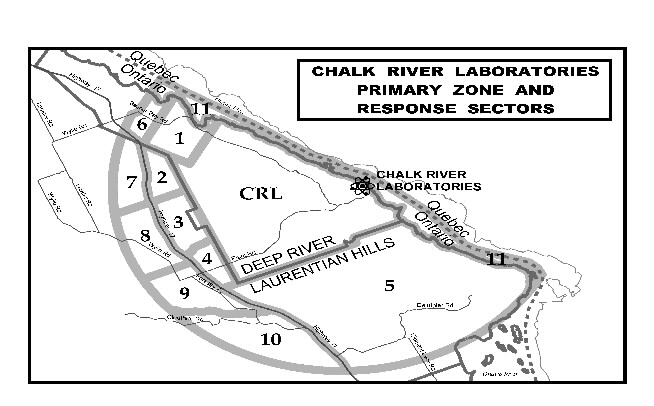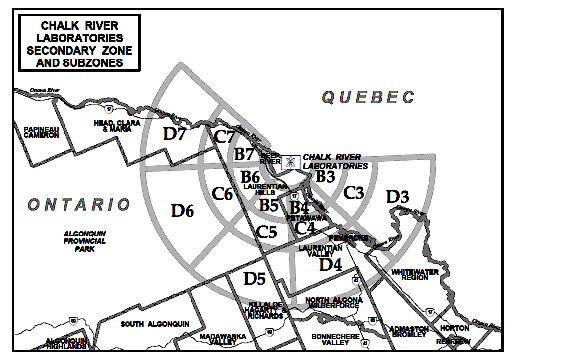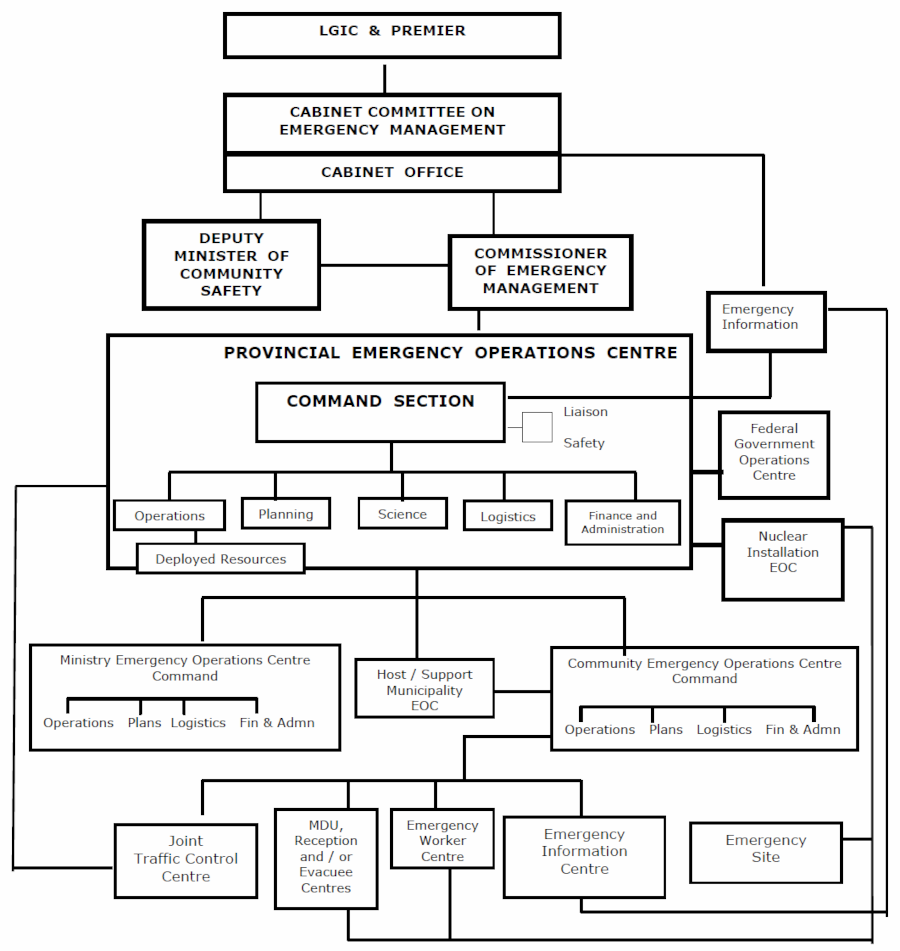Chapter 2: Plan data and organization
2.1 Atomic Energy of Canada Limited – Chalk River Laboratories (AECL-CRL)
2.1.1 AECL-CRL is located at latitude 46° 3' North and longitude 77° 22' West, on the south side of the Ottawa River, 200 km. northwest of the City of Ottawa.
2.1.2 AECL-CRL houses various licensed nuclear facilities including: research reactors, a molybdenum processing facility, a nuclear fuel fabrication laboratory, shielded facilities, a waste management area, a waste treatment centre, a recycled fuel fabrication laboratory and tritium handling facilities.
2.1.3 The National Research Universal (NRU) reactor has the greatest radioactive inventory of the facilities located at AECL-CRL The NRU reactor has no containment and therefore any radioactive release would be prompt with no capability to collect and retain the contamination. The NRU reactor functions include:
- Radioisotope production
- Experiments geared towards power reactor research
- Commercial irradiation
2.2 The potential hazard
2.2.1 If an accident were to occur at any of the facilities at AECL-CRL the most probable result would be that any effects, having a potentially significant health and safety impact, would not extend beyond the exclusion zone (see paragraph 2.4.1) surrounding the facility.
2.2.2 Less probable is an accident which may cause the"basic offsite effect" – a loss- of-coolant accident (LOCA) with no loss of emergency cooling systems and therefore no fuel failure. The principal characteristics of the offsite effect for an AECL-CRL emergency would be as follows:
- A very limited (or no) warning period might be available before offsite effects begin to occur, i.e. the release from the site could begin at the same time, or very soon after, the initiating event.
- The duration of the release could be short, e.g. as little as 1 hour.
- Doses would be low and are extremely unlikely to exceed 1 mSv (0.1 rem) at the site boundary i.e. the impact would be mainly confined to the exclusion zone (paragraph 2.4.1).
- Because of (c) above, Protective Action Levels (PALs) would not be exceeded offsite, therefore no protective measures would be required.
- Environmental contamination (if any) would be limited to low levels and to the exclusion zone.
Such an accident would likely result in an Enhanced Monitoring response by the Provincial Emergency Operations Centre (PEOC) (see Chapter 3).
2.2.3 Even less probable than the above type of accident is a loss of coolant accident (LOCA) combined with a malfunction or failure of the emergency cooling system, leading to a fraction of the fuel inventory being damaged and resulting in a release of radioactivity.
- The release could be prompt, i.e. within minutes of the initiating event.
- Doses could be such that PALs could be exceeded within the CRL Primary Zone (PZ), requiring public alerting and some protective actions (i.e. sheltering).
- A large fraction of fission product particulates and radioiodine would be removed by the emergency filtration system. However, all the noble gases would be immediately discharged through the reactor stack to the atmosphere.
- Environmental contamination would be higher than that for the basic offsite effect.
- The release duration could be very short, i.e. less than one hour for some emergencies.
Such an accident would likely result in (either a Partial or Full) Activation response by the PEOC (see Chapter 3).
2.3 Protective measures
The protective measures available for minimizing the radiation hazard in a nuclear emergency are listed in Table 2.1 and are defined in the glossary (Annex C). The operational use of these measures is described in appropriate sections of this plan.
2.4 Planning Zones
2.4.1 Exclusion Zone
The AECL-CRL exclusion zone encompasses a land area with approximately a 6 kilometre radius from the stack at AECL-CRL
2.4.2 Contiguous Zone
Because of the large exclusion area within the AECL-CRL boundary, no Contiguous Zone is designated.
2.4.3 Primary Zone
- The Primary Zone for AECL-CRL is shown in Figure 2.2.
- Its approximate radius is 9 kilometres and includes, in Renfrew County, a small portion of the Town of Deep River as far west as Banting Drive and that area of the Town of Laurentian Hills extending out to a 9 kilometre radius from the stack of the AECL-CRL facility. The Primary Zone further includes the area of the Ottawa River lying within the 9 km radius that also lies within the Province of Ontario. AECL-CRL is not included in the Primary Zone.
- For specific boundaries refer to Annex A.
- The Primary Zone is the area around the nuclear installation within which detailed planning and preparedness is carried out for measures against exposure to a radioactive plume. The approximate radius is 9 km from the stack at AECL-CRL
2.4.4 Secondary Zone
- The Secondary Zone encompasses areas of the County of Renfrew and the District of Nipissing (Algonquin Provincial Park) within a 50 km radius of AECL-CRL The Secondary Zone is shown in Figure 2.3 and includes the Primary Zone. Figure 2.3 also shows the sub-zones and sub-sectors of the Secondary Zone.
- The Secondary Zone is the area within which it is necessary to plan and prepare for taking Ingestion Control measures based on monitoring of the food chain for contamination.
2.4.5 The Province of Quebec will respond to the emergency affecting the area within the AECL-CRL Primary and Secondary Zones that lies within Quebec's borders (see Figure 2.2 and 2.3).
2.5 Response Sectors
2.5.1 The Primary Zone for AECL-CRL is divided into 11 response sectors as shown in Figure 2.2 and described in Annex A.
2.5.2 Highway 17 is the boundary between the inner (sectors 1-5) and outer rings (sectors 6-10) of the AECL-CRL Primary Zone.
2.5.3 Normally, protective measures apply to properties on both sides of a sector boundary. However, where the inner ring only is under a protective action order (e.g. sheltering), consideration will be given to reopening Highway 17 to traffic as soon as assurances are received that public health and safety will not be compromised.
2.5.4 Sector 11 falls within that portion of the Ottawa River that lies within a 9km radius of AECL-CRL up to the Ontario-Quebec boundary.
2.6 Planning Data
2.6.1 Planning Times
The licensed nuclear facilities at AECL-CRL including the NRU reactor, have only a limited containment capability (i.e. vented containment design). Depending on the nature of the accident, radioactivity would be emitted to the atmosphere commencing at the time of the accident, i.e. a prompt release. Radioactive emissions above significant levels could continue anywhere from approximately 1 hour to 24 hours.
2.6.2 Population Data
Estimates of the Primary Zone sector population figures are contained in Annex B.
2.7 Emergency Organization
2.7.1 The provincial emergency response organization for dealing with an AECL-CRL emergency is shown in Figure 2.4.
Overall coordination is provided by the Provincial Emergency Operations Centre (PEOC). Details on the roles and functions of the various elements of this organization can be found in the PNERP Master Plan, Chapter 4.
Table 2.1: Protective measures
Exposure Control Measures
- Entry Control
- Sheltering
- Evacuation
- Thyroid Blocking
- Use of Protective Equipment
- Decontamination
Ingestion Control Measures
- Milk Control
- Water Control
- Pasture Control
- Produce and Crop Control
- Livestock Control
- Food Control
- Land Control[*]
- Environmental Decontamination[*]
Note – These measures are described and discussed in the PNERP Master Plan, Chapter 6 and are defined in the Glossary, Annex C of this plan.
[*] Normally applicable only to the Recovery Phase


2.7.2 Liaison arrangements
- To ensure liaison and coordination between different elements of the emergency response organization, the following arrangements should be made:
- To PEOC:
- Each provincial ministry and agency with a role in the emergency response to provide a representative to join the PEOC (see PNERP Master Plan, Annex I).
- AECL-CRL to provide a representative to the PEOC.
- Provincial staff (PERT) to be deployed to join the Municipal (EOC).
- Federal Liaison representative(s) to join the PEOC.
- CNSC representative to join the PEOC.
- The Province of Quebec to deploy a representative to the PEOC.
- To Municipal EOC:
- AECL-CRL to provide a liaison officer to the Municipal Emergency Operations Centre (EOC).
- To PEOC:
- The role of the AECL-CRL liaison officer at the Municipal EOC will be to act as a link to the appropriate authorities at AECL-CRL for the following types of issues:
- AECL-CRL support to the municipalities, e.g. Monitoring & Decontamination Units and Emergency Worker Centres.
- Requests for assistance (e.g., for additional personal monitoring resources, stable iodine tablets, fire or Emergency Medical Services at AECL-CRL).
- Coordination of the evacuation of non-essential AECL-CRL staff, and of the movement of essential staff to and from the site.
- Facilitating the work of the offsite field monitoring teams.
- Providing situational updates related to the emergency at the nuclear facility.
- Providing technical briefings to the Municipal EOC staff in order to clarify the context within which the operational situation may be understood.
2.7.3 Joint Traffic Control Centre
A Joint Traffic Control Centre (JTCC) shall be set up and staffed for an AECL-CRL emergency to implement the Joint Traffic Control Plan made under section 1.4, upon notification of either a Partial or Full Activation response by the Province.
2.7.4 Municipal Organization
The Towns of Laurentian Hills and Deep River shall set up a municipal emergency response organization as prescribed in the Municipal Plan.
2.7.5 Provincial ministry offices
The following regional/district/area offices of Provincial ministries shall be prepared to respond to the emergency and to provide the necessary assistance to the designated municipalities, as required by the PNERP Master Plan, Annex I, and detailed in the Municipal Plan or, as directed by their respective ministries:
- Agriculture , Food & Rural Affairs
Kemptville Area Office
- Community & Social Services
Eastern Region
- Environment
Eastern Region Office - Kingston
Ottawa District Office
- Health and Long-Term Care
Renfrew Central Ambulance Communications Centre.
- Labour
Eastern Region Office - Ottawa
- Natural Resources
Pembroke District Office
Algonquin Provincial Park
Driftwood Provincial Park
- Community Safety and Correctional Services
Central Region HQ, OPP (Orillia)
Eastern Region HQ, OPP (Smiths Falls)
North Eastern Region HQ, OPP (North Bay)
Highway Safety Division, OPP (Aurora)
- Transportation
MTO Eastern Region - Kingston
MTO Northeastern Region – North Bay
2.7.6 Host municipality
- Pursuant to subsection 3(4) of the Emergency Management and Civil Protection Act, R.S.O. 1990, c.E.9, the Town of Deep River has been designated as a host municipality (see PNERP Master Plan, Annex A) and, as such must address responsibilities for nuclear emergencies in its municipal emergency plan (formulated under subsection 3(1) of the Emergency Management and Civil Protection Act).
- The PNERP Master Plan, Annex I provides details on designated (host) municipality responsibilities, including the appropriate preparations to receive, shelter and care for evacuees.
2.7.7 Support municipalities
In the event of a declared provincial emergency, the Premier or LGIC may order a municipality to provide support or assistance to the affected, designated municipalities at the time of the emergency (as authorized by sections 7.0.2(4) or 7.0.3 of the EMCPA).
2.8 Contingency provisions
2.8.1 The PEOC shall normally coordinate the emergency management and response organization through the centres in the tier below it (see Figure 2.4). However, if for any reason any of these centres are not functioning or are not responsive, the PEOC may issue directions directly to any element of the emergency response organization.
2.8.2 Likewise, in the absence of contact with the PEOC, these organizations are responsible for taking appropriate actions, according to plans, procedures and the requirements of the situation and, as far as possible, in coordination with other responding organizations.
2.9 Emergency facilities
The location of the various local emergency centres and facilities to be established, pursuant to this plan, are detailed in the Municipal Plan.
2.10 Telecommunications
2.10.1 All emergency centres and facilities are linked through landline phone as well as other systems, which also enable facsimile transmission (fax), email and data transfer.
2.10.2 AECL-CRL should arrange the establishment of reliable contingency communications between and amongst the following centres:
- Provincial Emergency Operations Centre
- AECL-CRL
- Municipal Emergency Operations Centre
- Joint Traffic Control Centre
2.10.3 All organizations and agencies involved in responding to an AECL-CRL nuclear emergency should ensure the availability of backup telecommunications system e.g. cell phones and satellite phones.
